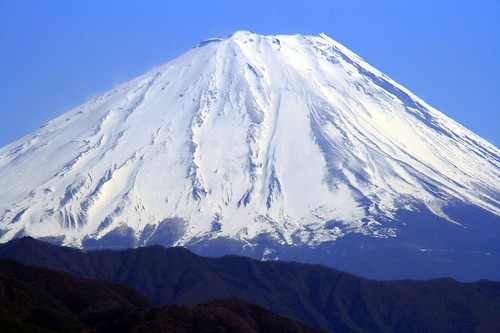Facts about Japan, Fast facts about Japan, 10 Facts about Japan, Funny Japan facts, Interesting facts about Japan, Japan facts
Monday, October 27, 2008
Facts about japan:Japan Shinkansen train
Japan train network is without doubt the finest s in the world,particularly the fastest Japan Shinkansen train or Japanese Bullet Train that links the major Japanese cities.
Japan's fast Bullet trains are named Shinkansen and are controlled by the Japan Railways.Japan train network allows traveling at a maximum speed of 270km/h.Shinkansen trains use independent rails and platforms separated from all other trains. All Shinkansen routes start out and finish at Tokyo's main stations.
The Shinkansen trains are the most favorite form of transport in Japan.Shinkansen train today has turn in to one of the most typical part of Japan's super modern rail transportation system.
Since the 1964 when Shinkansen trains went in operation the Shinkansen have registered no fatal accidents.
Monday, August 25, 2008
Mount Fuji, Japan
Mount Fuji (Fujisan) is with 3776 meters Japan's highest mountain. It is not surprising that the nearly perfectly shaped volcano has been worshipped as a sacred mountain and experienced big popularity among artists and common people.
Mount Fuji is a dormant volcano, which most recently erupted in 1708. It stands on the border between Yamanashi and Shizuoka Prefectures and can be seen from Tokyo and Yokohama onclear days.
Saturday, August 16, 2008
Facts about japan:Is this really Japan ?
Is this really Japan ?
Originally uploaded by Monkey D Lueffy
Yes it is the liberty Station and yes it is Japan. In fact this statue is the french twin of the New York Famous one. The statue was lend to Japan one year and they put it in Odaiba. Behind is the rainbow bridge, one of the biggest bridge of Japan (except the one that tied Shikoku and Honshu near Kobe).

Thursday, May 15, 2008
Facts about Japan:Zen Garden
Sunday, May 11, 2008
Facts about Japan:Japan traditional food

Japanese culinary art personifies its environment and populate. The easiness of getting fresh components led to sushi, high temperature and humidness led to assortments of preserved food like umeboshi,natto, tsukemono and soja sauce.A few good example of traditionalistic Japanese food are Sushi, Soba and ‘Modern’ is specified as specifically Japanese, but converted or influenced by western civilization. A couple of good examples of moderne Japanese fast food restaurant are Mos Burger,and Yoshinoya.

Japanese food is often adverted in connection with a healthy diet because of the large quantity of fish and vegetables and it become a popular type of health food n the U.S. and Europe.
Cooking method of Japanese Traditional food Kansai Style OKONOMI-YAKI:
Friday, May 9, 2008
Facts about Japan:Funny Japan videos
Japanese bear the repute of being a serious ethnic society that honours traditional values and has a serious, moderate approach to living. Japanese would surely profit in if they could loosen a little more, accept life little less seriously and make fun of themselves like they do in this funny videos:
Funny Japan Commercial:
A collection of hilarious pranks from Japanese TV:
Japanese crazy taxi extreme prank:
Funny Japanese game show - marshmallow eating:
MAtrix Ping Pong:
Wednesday, May 7, 2008
Facts about japan:Capsule hotel
A Brand-new trend in Japan are extremely small hotel rooms, configured for Japanese business people. The capsules in these "tube hotels" measure just two square meters and one meter tall.
Nearly all of the capsules are for men, and just few for women.
Each capsule unit has a television, radio set, alarm clock and adaptable lighting and each of these devices may be controlled while laying down, as if you were in a spacecraft.
Saturday, May 3, 2008
Facts about earthquakes in Japan
Japan earthquake facts
• Japan,is located along the “circle of fire” arc of volcanoes and sea ditches that partly surrounds the Pacific Basin, accounts for almost twenty pct of the earths quakes of magnitude six or bigger.
• A earth tremor happens in Japan at the least every five minutes, and every year there are up to 2,000 earthquakes that can be sensed by inhabit.
• The Great Kanto earthquake of September 1, 1923, which had a order of magnitude of 7.9, killed more than one hundred forty,000 people in the Japanese capital area. Seismologists have told another such earthquake could smash the city at any time.
• Jan 16, 1995, an earthquake with a magnitude of 7.3 smash central Japanese Islands, crushing the western port urban center of Kobe. It was the most intense quake to strike Japanese Islands in fifty years, killing more than 6,400 and causing an estimated $100 billion in damage.
• Oct twenty-three, 2004, a 6.8 magnitude earthquake affected the Niigata area, about 250 km in the north of Japanese capital, killing sixty-five citizenry and hurting 3,000.
• March 25, 2007, a 6.9 magnitude earthquake affected the Noto peninsula in Ishikawa prefecture, approximately three hundred km west of Japanese capital, killing one-man, wounding additional 200 and destructing hundreds of houses.
• The Tokyo-Yokohama area, with a population of 35 million, bears the highest evaluation by earthy disasters such as quakes of any of the world’s 30 “megacities”, the report stated.










